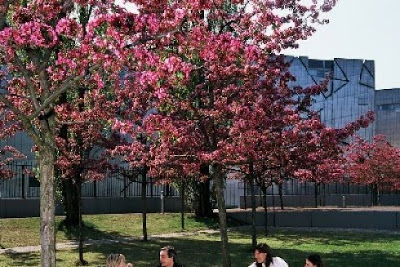Far away from this weekend's Art Forum Berlin at the Messehalle, is an empty museum open to the public -- the best tip I received for the week.
Photo: ⓒ Adrian Welsh
Berlin's Well-Kept Secrets
Berlin has seen the "empty museum" phenomenon before. In 1999, visitors who took part in an architectural tour of the Jewish Museum before a single exhibit had been moved inside, sensed the powerful atmosphere created by Daniel Libeskind's design. In March this year, the empty Neues Museum on Museum Island (due to open this October) invited in the public one weekend and created a sensation.
This time it is the Bauhaus Archive/Museum of Design. All its exhibits are currently at the Martin-Gropius-Bau in the largest Bauhaus exhibition ever to be presented: "Bauhaus: A Conceptual Model," which runs till October 4. In the meantime, the Bauhaus Archive, stripped of its collection, is open to the public.
Photo: ⓒ Adrian Welsh
A Space Transformed
In its empty state, the building has undergone a dramatic transformation.
Originally designed in the 1960s by Walter Gropius for a steeply sloping site in Darmstadt, the museum was finally built ten years later on flat terrain in Berlin's Tiergarten. When architects had to adjust the ground plans, they turned the building's axis 180°. This meant that the large exhibition hall, with its floor to ceiling windows, now faced south instead of north, constantly open to sunlight. The curators worried about protecting the exhibits from over-exposure.
The solution was dark shades that covered all the glass and viewing galleries around the building, as well as the skylights on the saw-toothed roofs. This worked for conservation purposes but, of course, changed the character of the building as envisaged by its creator.
Now the shades are off. Light floods in through the South Hall windows, the galleries and the skylights. Suddenly, the whole building is transparent. Interiors harmonize with the surrounding landscape as the vista of the Landwehr Canal, curving alongside, opens up. Ah! you think, here -- finally! -- is the real beauty of Gropius's plan.
Don't Miss
Here are five things not to miss when you visit:
1. A guided tour or audio-guide -- both have interesting anecdotes about past and future plans for the building
2. The replica of Gropius's 60s chrome breakfast bar, left over from a previous exhibition and standing in the South Hall
3. The cafe, which offers a Create your Own Sandwich special. The concept is graphic designer Susann Unger's, and is pure Bauhaus. You "build" your sandwich on a plain wooden board -- your choice of bread with a selection of spreads arranged in small glass jars, all specialties from local manufacturers: three peppercorn or tomato-basil butter, pure raspberry, apricot-lavender or ricotta-mint. Perfect!
4. An old patio table by the Landwehr Canal where you can enjoy your creative sandwich under the trees in peace and quiet
5. The museum shop, which has wonderful design items (some of them quite affordable) for the home and office. (I have my eye on a certain teapot.)
The empty Bauhaus-Archiv/Museum für Gestaltung is open to the public in its "schön anzusehen" ("a beautiful sight") program, which runs till October 4. The museum is located at Klingelhöferstraße 14 (S and U-Bahn Zoologischer Garten). Take Bus 100 from the station till Budapesterstraße, then walk north to the Lützowerufer, cross the bridge over the Landwehrkanal, and you will see the distinctive industrial-style roof of the museum on your right -- about a 5-10 minute walk.
The museum is open daily, except Tuesdays, from 10 am to 5 pm. Tickets are 3 EUR (reduced fee, 1.50 EUR) and include an audio guide. The program also includes architectural tours and film shows.
More information is at www.bauhaus.de
This year is the 90th anniversary of the foundation of the Bauhaus.










